Looking to quickly come up to speed on some frequently used picture framing vocabulary? Apparent Software, makers of ImageFramer, are pleased to bring you this Framing and Art Alphabet, a handy glossary for appreciating art and making or enhancing your own.
A
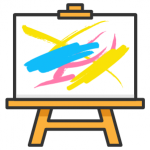 Artwork – an object of aesthetic value; material product of artistic creativity. Includes such art pieces as paintings, drawings, photographs and other forms of visual art.
Artwork – an object of aesthetic value; material product of artistic creativity. Includes such art pieces as paintings, drawings, photographs and other forms of visual art.
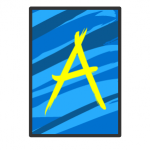 Accent – an emphasis on any face, object or detail of artwork with color, light or composition. Helps the viewer to pay particular attention to the artist’s main characters and idea.
Accent – an emphasis on any face, object or detail of artwork with color, light or composition. Helps the viewer to pay particular attention to the artist’s main characters and idea.
B
 Background – the main color or tone of a picture, where the artwork scene is drawn. Usually based the farthest from the viewer.
Background – the main color or tone of a picture, where the artwork scene is drawn. Usually based the farthest from the viewer.
C
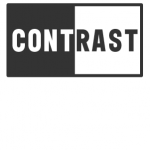 Contrast – in visual art is usually shown as sharply opposing of colors. For example, a high contrast photograph is a photograph with extreme (the lightest and darkest) tonalities. On the other hand, a low contrast photo has a more similar range of tones. White and black colors usually have the greatest contrast.
Contrast – in visual art is usually shown as sharply opposing of colors. For example, a high contrast photograph is a photograph with extreme (the lightest and darkest) tonalities. On the other hand, a low contrast photo has a more similar range of tones. White and black colors usually have the greatest contrast.
Want to learn more about the importance of contrast in paintings and graphic art? Check out this informative blog post, Contrast in Art and the Value of the Opposites.
 Cropping – used to adjust an image (usually a photo) to a specific format (such as a 4:3 aspect ratio or a 5×7” print) or to improve its composition. Cropping is often used to remove unnecessary image details by cutting off picture edges.
Cropping – used to adjust an image (usually a photo) to a specific format (such as a 4:3 aspect ratio or a 5×7” print) or to improve its composition. Cropping is often used to remove unnecessary image details by cutting off picture edges.
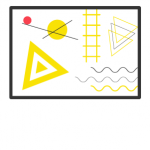 Composition – construction of an artwork taking into account its content and character. Composition is the most important element of artistic form and provides an image with integrity and power. The right arrangement of elements in the picture helps concentrate the viewer’s attention on the most expressive parts of an artwork.
Composition – construction of an artwork taking into account its content and character. Composition is the most important element of artistic form and provides an image with integrity and power. The right arrangement of elements in the picture helps concentrate the viewer’s attention on the most expressive parts of an artwork.
Want to make your art more attractive to the viewer? Check out 12 Pro Tips to Improve your Artistic Composition
D
 Digital art – direction in media art, based on the use of information (computer) technology. Paintings created with the help of computer software (for example digital photography or photopainting), are known as digital paintings.
Digital art – direction in media art, based on the use of information (computer) technology. Paintings created with the help of computer software (for example digital photography or photopainting), are known as digital paintings.
Read more about How to Frame Your Digital Photos
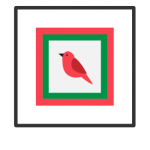 Double Mat – consists of two (sometimes three or more) mat boards of different tones. The color of an inner mat is usually chosen from a specific color on the image to enhance it.
Double Mat – consists of two (sometimes three or more) mat boards of different tones. The color of an inner mat is usually chosen from a specific color on the image to enhance it.
A double mat helps to make a deeper expression of artwork and emphasize figures and elements with a variety of colors.
E
 Enlargement – the technique of printing a photograph, making it bigger than on the original negative.
Enlargement – the technique of printing a photograph, making it bigger than on the original negative.
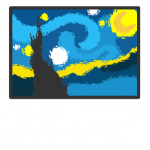 Expressionism – a genre of visual art that appeared in the first decade of the 20th century in Germany and Austria. Characterized by distortion of forms, dynamism, exaltation and the grotesque in order to create a powerfully expressive image and reflect the author’s worldview.
Expressionism – a genre of visual art that appeared in the first decade of the 20th century in Germany and Austria. Characterized by distortion of forms, dynamism, exaltation and the grotesque in order to create a powerfully expressive image and reflect the author’s worldview.
F
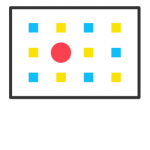 Focal point – the center of interest of an artwork that demands the most attention. Usually, it’s the part you look at first and the most important element on the picture, the main idea of an artist.
Focal point – the center of interest of an artwork that demands the most attention. Usually, it’s the part you look at first and the most important element on the picture, the main idea of an artist.
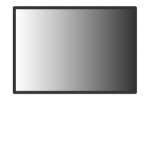 Fading – a gradual change of one color or shade to another.
Fading – a gradual change of one color or shade to another.
G
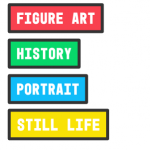 Genre – a set of artworks, combined by visual subject matter or a way of understanding and interpretation. Examples include portrait, landscape, historical genre and so on.
Genre – a set of artworks, combined by visual subject matter or a way of understanding and interpretation. Examples include portrait, landscape, historical genre and so on.
 Graphic – a type of visual art that uses contour lines, strokes, spots and white background as the main technique. Color can also be applied, but, unlike in painting, it doesn’t play the main role. Includes drawings and printed artworks (etching, lithography, bookplate).
Graphic – a type of visual art that uses contour lines, strokes, spots and white background as the main technique. Color can also be applied, but, unlike in painting, it doesn’t play the main role. Includes drawings and printed artworks (etching, lithography, bookplate).
H
 Horizon line – an imaginary line that shows where the sky meets the land. Location of the horizon line (whether low or high) affects an atmosphere of the artwork.
Horizon line – an imaginary line that shows where the sky meets the land. Location of the horizon line (whether low or high) affects an atmosphere of the artwork.
Read more about the impact of the horizon line to the perspective of the picture here – How the Horizon Line Controls Perspective in Art
I
 ImageFramer – the Mac application to add artistic, holiday or photorealistic frames and borders to your photos or art images.
ImageFramer – the Mac application to add artistic, holiday or photorealistic frames and borders to your photos or art images.
L
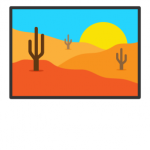 Landscape – fine art genre, where nature plays the main role of composition. Could be either wild nature or transformed by people (for example parks and gardens).
Landscape – fine art genre, where nature plays the main role of composition. Could be either wild nature or transformed by people (for example parks and gardens).
M
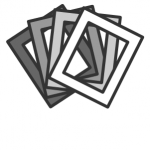 Mat (or moulding) – a physical or virtual inner layer between the frame and the image that enhances the aesthetic impact of artwork.
Mat (or moulding) – a physical or virtual inner layer between the frame and the image that enhances the aesthetic impact of artwork.
Experimenting with color and texture of the mat, you can create a three-dimensional effect, visually reduce or enlarge parts of the image, and/or emphasize warm or cold tones. The color and texture of the mat can change the perception of an artwork as a whole.
 Monochrome – this term describes a piece of art created using one color, but various shades of this color, such as a photo made in different gradations of grey.
Monochrome – this term describes a piece of art created using one color, but various shades of this color, such as a photo made in different gradations of grey.
N
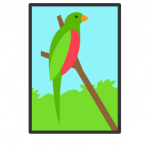 Naturalism – the direction in visual art that has developed in the last third of the 20th century. The main goal of naturalism is to objectively show the observed reality with accuracy to details and without any exaggeration.
Naturalism – the direction in visual art that has developed in the last third of the 20th century. The main goal of naturalism is to objectively show the observed reality with accuracy to details and without any exaggeration.
Want to see the best examples of naturalism artworks? Check out Important Art and Artists of Naturalism
O
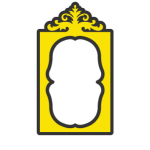 Ornamentation – an artistic decoration or pattern, usually made with plant or animal design motifs, often used to beautify the picture frame.
Ornamentation – an artistic decoration or pattern, usually made with plant or animal design motifs, often used to beautify the picture frame.
 Overlap – In framing, used to describe the extent to which a piece of art is covered by its mat. This can create the illusion of depth and focus on particular elements of the picture.
Overlap – In framing, used to describe the extent to which a piece of art is covered by its mat. This can create the illusion of depth and focus on particular elements of the picture.
 Original artwork – a piece of art created personally by an artist. It can be quite tricky with prints and photos as it is difficult to discern the difference between reproductions
Original artwork – a piece of art created personally by an artist. It can be quite tricky with prints and photos as it is difficult to discern the difference between reproductions
P
 Picture Frame – an attractive border fitted around the picture. Serves to enhance the desired details, hide flaws and create a complete, perfect piece of art.
Picture Frame – an attractive border fitted around the picture. Serves to enhance the desired details, hide flaws and create a complete, perfect piece of art.
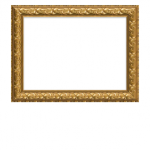 Photorealistic picture frame – a digital picture frame, created using computer technology and photos of real frames. Looks like a physical picture frame and can be fitted to images of different sizes.
Photorealistic picture frame – a digital picture frame, created using computer technology and photos of real frames. Looks like a physical picture frame and can be fitted to images of different sizes.
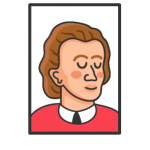 Portrait – a genre of visual art used in painting, drawing or photography. Describes an artwork containing an image of a certain person or group of people.
Portrait – a genre of visual art used in painting, drawing or photography. Describes an artwork containing an image of a certain person or group of people.
R
 Reveal – a visible part of inner mat when using double or triple matting.
Reveal – a visible part of inner mat when using double or triple matting.
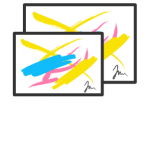 Replica – an author’s copy of the artwork, different from the original in size or minor details.
Replica – an author’s copy of the artwork, different from the original in size or minor details.
S
 Sepia – very common style in painting, drawing, and photography. Describes a light brown tint; color, which prevails on old retro black and white photographs (which are often, in fact, brown).
Sepia – very common style in painting, drawing, and photography. Describes a light brown tint; color, which prevails on old retro black and white photographs (which are often, in fact, brown).
Literally, sepia is translated as “squid” due to the fact that the original paint of this color is made from ink bags of squids.
 Style – different types of art and framing usually depending on a particular era or national features.
Style – different types of art and framing usually depending on a particular era or national features.
T
 Text and image overlay – provides the ability to put text or image over a chosen picture. Using this easy technique helps to make your photos unique, advertise your product more successfully or give some extra information to your viewers.
Text and image overlay – provides the ability to put text or image over a chosen picture. Using this easy technique helps to make your photos unique, advertise your product more successfully or give some extra information to your viewers.
 Technique – manner or way expressed by an artist to create an artwork. Includes watercolor, acrylic and oil paintings, gouache, graffiti etc.
Technique – manner or way expressed by an artist to create an artwork. Includes watercolor, acrylic and oil paintings, gouache, graffiti etc.
V
 Vantage point – a point from where the photo is taken. Usually shows the best perspective of the view and describes the viewer’s understanding of composition.
Vantage point – a point from where the photo is taken. Usually shows the best perspective of the view and describes the viewer’s understanding of composition.
 Vernacular photography – a genre of photography that shows everyday life and scenes. This is not an artistic type of photography and usually is taken by ordinary people. Includes snapshots of friends, family and domestic scenes of life.
Vernacular photography – a genre of photography that shows everyday life and scenes. This is not an artistic type of photography and usually is taken by ordinary people. Includes snapshots of friends, family and domestic scenes of life.
W
 Watermark – faint text placed on the top of the picture. Serves to protect your photo or any other digital artwork from copyrighting. Also can be a good way of branding and advertisement.
Watermark – faint text placed on the top of the picture. Serves to protect your photo or any other digital artwork from copyrighting. Also can be a good way of branding and advertisement.
Read about Pros and Cons of using Watermark
 Watercolor – the technique of visual art between painting and graphics. The watercolor artist works with water-based paints on paper or cardboard. Watercolor paints mix easily with water, spread on the surface of the paper and must be treated with special care while working.
Watercolor – the technique of visual art between painting and graphics. The watercolor artist works with water-based paints on paper or cardboard. Watercolor paints mix easily with water, spread on the surface of the paper and must be treated with special care while working.
ImageFramer 4: Your art. Showcased.
Download the best-in-class Mac app for adding photorealistic frames and mats to photos and artwork today.